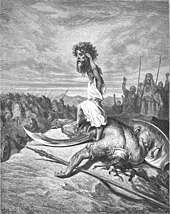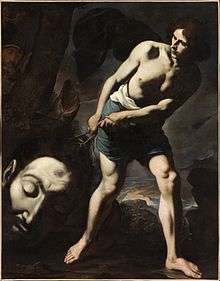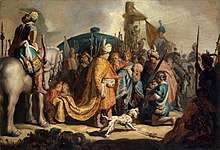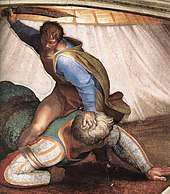Goliath
Goliath (/ɡəˈlaɪəθ/ gə-LY-əth)[lower-alpha 1] is described in the biblical Book of Samuel as a Philistine giant defeated by the young David in single combat. The story signified Saul's unfitness to rule, as Saul himself should have fought for Israel.[1] Scholars today believe that the original listed killer of Goliath was Elhanan, son of Jair, and that the authors of the Deutoronomic history changed the original text to credit the victory to the more famous character, David.[2]

The phrase "David and Goliath" has taken on a more popular meaning, denoting an underdog situation, a contest where a smaller, weaker opponent faces a much bigger, stronger adversary.[3]
Biblical account

The Goliath narrative in 1 Samuel 17
Saul and the Israelites are facing the Philistines in the Valley of Elah. Twice a day for 40 days, morning and evening, Goliath, the champion of the Philistines, comes out between the lines and challenges the Israelites to send out a champion of their own to decide the outcome in single combat, but Saul is afraid. David accepts the challenge. Saul reluctantly agrees and offers his armor, which David declines, taking only his staff, sling and five stones from a brook.
David and Goliath confront each other, Goliath with his armor and javelin, David with his staff and sling. "The Philistine cursed David by his gods", but David replies: "This day the Lord will deliver you into my hand, and I will strike you down; and I will give the dead bodies of the host of the Philistines this day to the birds of the air and to the wild beasts of the earth; that all the earth may know that there is a God in Israel, and that all this assembly may know that God saves not with sword and spear; for the battle is God's, and he will give you into our hand."
David hurls a stone from his sling and hits Goliath in the center of his forehead, Goliath falls on his face to the ground, and David cuts off his head. The Philistines flee and are pursued by the Israelites "as far as Gath and the gates of Ekron". David puts the armor of Goliath in his own tent and takes the head to Jerusalem, and Saul sends Abner to bring the boy to him. The king asks whose son he is, and David answers, "I am the son of your servant Jesse the Bethlehemite."
Composition of the Book of Samuel and the Goliath narrative
The Books of Samuel, together with the books of Joshua, Judges and Kings, make up a unified history of Israel which biblical scholars call the Deuteronomistic history. The first edition of the history was probably written at the court of Judah's King Josiah (late 7th century BCE) and a revised second edition during the exile (6th century BCE), with further revisions in the post-exilic period.[4][5] Traces of this can be seen in the contradictions and illogicalities of the Goliath story - to take a few examples, David turns from Saul's adult shield-bearer into a child herding sheep for his father, Saul finds it necessary to send for him when as the king's shield-bearer he should already be beside his royal master, and then has to ask who David is, which sits strangely with David's status at his court.[6] The Goliath story is made up of base-narrative with numerous additions made probably after the exile:[7]
- Original story
- The Israelites and Philistines face each other; Goliath makes his challenge to single combat;
- David volunteers to fight Goliath;
- David selects five smooth stones from a creek-bed to be used in his sling;
- David defeats Goliath, the Philistines flee the battlefield.
- Additions
- David is sent by his father to bring food to his brothers, hears the challenge, and expresses his desire to accept;
- Details of the account of the battle;
- Saul asks who David is, and he is introduced to the king through Abner.[8][lower-alpha 2]
Textual considerations
Goliath's height


The oldest manuscripts, namely the Dead Sea Scrolls text of Samuel from the late 1st century BCE, the 1st-century CE historian Josephus, and the major Septuagint manuscripts, all give it as "four cubits and a span" (6 feet 9 inches or 2.06 metres), whereas the Masoretic Text has "six cubits and a span" (9 feet 9 inches or 2.97 metres).[9][10] Many scholars have suggested that the smaller number grew in the course of transmission (only a few have suggested the reverse, that an original larger number was reduced), possibly when a scribe's eye was drawn to the number six in line 17:7.[11]
Goliath and Saul

The underlying purpose of the story of Goliath is to show that Saul is not fit to be king (and that David is). Saul was chosen to lead the Israelites against their enemies, but when faced with Goliath he refuses to do so; Saul is a very tall man, but Goliath is a giant. Saul's exact height is not given, but he was a head taller than anyone else in all Israel (1 Samuel 9:2), which implies he was over 6 feet (1.8 m) tall and the obvious challenger for Goliath, yet, David is the one who eventually defeated him. Also, Saul's armour and weaponry are apparently no worse than Goliath's (and David, of course, refuses Saul's armour in any case). "David declares that when a lion or bear came and attacked his father's sheep, he battled against it and killed it, [but Saul] has been cowering in fear instead of rising up and attacking the threat to his sheep (i.e. Israel)."[10]
Elhanan and Goliath
2 Samuel 21:19 tells how Goliath the Gittite was killed by "Elhanan the son of Jaare-oregim, the Bethlehemite." Scholars believe that the original killer of Goliath was Elhanan, and that the authors of the Deutoronomic history changed the text to credit the victory to the more famous character, David.[2] The fourth-century BC 1 Chronicles 20:5 explains the second Goliath by saying that Elhanan "slew Lahmi the brother of Goliath", constructing the name Lahmi from the last portion of the word "Bethlehemite" ("beit-ha’lahmi"), and the King James Bible adopted this into 2 Samuel 21:18–19, but the Hebrew text at Goliath’s name makes no mention of the word "brother".[12]
Goliath and the Greeks
The armor described in 1 Samuel 17 appears typical of Greek armor of the sixth century BCE rather than of Philistines armor of the tenth century; narrative formulae such as the settlement of battle by single combat between champions has been thought characteristic of the Homeric epics (the Iliad) rather than of the ancient Near East. The designation of Goliath as a איש הביניים, "man of the in-between" (a longstanding difficulty in translating 1 Samuel 17) appears to be a borrowing from Greek "man of the metaikhmion (μεταίχμιον)", i.e. the space between two opposite army camps where champion combat would take place.[13]
A story very similar to that of David and Goliath appears in the Iliad, written circa 760–710 BCE, where the young Nestor fights and conquers the giant Ereuthalion.[14][15] Each giant wields a distinctive weapon—an iron club in Ereuthalion's case, a massive bronze spear in Goliath's; each giant, clad in armor, comes out of the enemy's massed array to challenge all the warriors in the opposing army; in each case the seasoned warriors are afraid, and the challenge is taken up by a stripling, the youngest in his family (Nestor is the twelfth son of Neleus, David the seventh or eighth son of Jesse). In each case an older and more experienced father figure (Nestor's own father, David's patron Saul) tells the boy that he is too young and inexperienced, but in each case the young hero receives divine aid and the giant is left sprawling on the ground. Nestor, fighting on foot, then takes the chariot of his enemy, while David, on foot, takes the sword of Goliath. The enemy army then flees, the victors pursue and slaughter them and return with their bodies, and the boy-hero is acclaimed by the people.[16]
Goliath's name
Tell es-Safi, the biblical Gath and traditional home of Goliath, has been the subject of extensive excavations by Israel's Bar-Ilan University. The archaeologists have established that this was one of the largest of the Philistine cities until destroyed in the ninth century BC, an event from which it never recovered. A potsherd discovered at the site, and reliably dated to the tenth to mid-ninth centuries BC, is inscribed with the two names "alwt" and "wlt". While the names are not directly connected with the biblical Goliath ("glyt"), they are etymologically related and demonstrate that the name fits with the context of late-tenth/early-ninth-century BC Philistine culture. The name "Goliath" itself is non-Semitic and has been linked with the Lydian king Alyattes, which also fits the Philistine context of the biblical Goliath story.[17] A similar name, Uliat, is also attested in Carian inscriptions.[18] Aren Maeir, director of the excavation, comments: "Here we have very nice evidence [that] the name Goliath appearing in the Bible in the context of the story of David and Goliath … is not some later literary creation."[19]
Later traditions
Jewish
According to the Babylonian Talmud (Sotah 42b) Goliath was a son of Orpah, the sister-in-law of Ruth, David's own great grandmother (Ruth → Obed → Jesse → David). Ruth Rabbah, a haggadic and homiletic interpretation of the Book of Ruth, makes the blood-relationship even closer, considering Orpah and Ruth to have been full sisters. Orpah was said to have made a pretense of accompanying Ruth but after forty paces left her. Thereafter she led a dissolute life. According to the Jerusalem Talmud Goliath was born by polyspermy, and had about one hundred fathers.[20]
The Talmud stresses Goliath's ungodliness: his taunts before the Israelites included the boast that it was he who had captured the Ark of the Covenant and brought it to the temple of Dagon; and his challenges to combat were made at morning and evening in order to disturb the Israelites in their prayers. His armour weighed 60 tons, according to rabbi Hanina; 120, according to rabbi Abba bar Kahana; and his sword, which became the sword of David, had marvellous powers. On his death it was found that his heart carried the image of Dagon, who thereby also came to a shameful downfall.[21]
In Pseudo-Philo, believed to have been composed between 135 BC and 70 AD, David picks up seven stones and writes on them his father's name, his own name, and the name of God, one name per stone; then, speaking to Goliath, he says "Hear this word before you die: were not the two woman from whom you and I were born, sisters? And your mother was Orpah and my mother Ruth ..." After David strikes Goliath with the stone he runs to Goliath before he dies and Goliath says "Hurry and kill me and rejoice." and David replies "Before you die, open your eyes and see your slayer." Goliath sees an angel and tells David that it is not he who has killed him but the angel. Pseudo-Philo then goes on to say that the angel of the Lord changes David's appearance so that no one recognizes him, and thus Saul asks who he is.[22]
Islam
Goliath appears in chapter 2 of the Qur'an (2: 247–252), in the narrative of David and Saul's battle against the Philistines.[23] Called "Jalut" in Arabic ("جالوت"), Goliath's mention in the Quran is concise, though it remains a parallel to the account in the Hebrew Bible. Muslim scholars have tried to trace Goliath's origins, most commonly with the Amalekites.[24] Goliath, in early scholarly tradition, became a kind of byword or collective name for the oppressors of the Israelite nation before David.[23] Muslim tradition sees the battle with the Philistines as a prefiguration of Muhammad's battle of Badr, and sees Goliath as parallel to the enemies that Muhammad faced.[24]
Adaptations

American actor Ted Cassidy portrayed Goliath in the TV series Greatest Heroes of the Bible in 1978.[25] Italian actor Luigi Montefiori portrayed this 9 ft 0 in (2.74 m)-tall giant in Paramount's 1985 live-action film King David as part of a flashback. This film includes the King of the Philistines saying, "Goliath has challenged the Israelites six times and no one has responded." It is then on the seventh time that David meets his challenge.
The PBS series Wishbone featured Goliath in its first-season episode "Little Big Dog".
Big Idea's popular VeggieTales episode was called "Dave and the Giant Pickle", where Phil Vischer voiced Goliath.
In 1972, Toho and Tsuburaya Productions collaborated on a film called Daigoro vs. Goliath, which follows the story relatively closely but recasts the main characters as Kaiju.
In 1975, Israeli band Poogy release a song called Golyat on the album Tzafoof BaOzen, loosely and humorously based on the story.
Suzanne Vega's song Rock In This Pocket (Song Of David) on the album 99.9°F is based on the story.
In 2005, Lightstone Studios released a direct-to-DVD movie musical titled "One Smooth Stone", which was later changed to "David and Goliath". It is part of the Liken the Scriptures (now just Liken) series of movie musicals on DVD based on scripture stories. Thurl Bailey, a former NBA basketball player, was cast to play the part of Goliath in this film.
In 2009, NBC aired Kings which has a narrative loosely based on the Biblical story of King David, but set in a kingdom that culturally and technologically resembles the present-day United States.[26] The part of Goliath is portrayed by a tank, which David destroys with a shoulder fired rocket launcher.
Goliath was portrayed by Conan Stevens in the 2013 TV miniseries The Bible.
Italian Goliath film series (1960–1964)
The Italians used Goliath as an action superhero in a series of biblical adventure films (peplums) in the early 1960s. He possessed amazing strength, and the films were similar in theme to their Hercules and Maciste movies. After the classic Hercules (1958) became a blockbuster sensation in the film industry, the 1959 Steve Reeves film Terrore dei Barbari (Terror of the Barbarians) was retitled Goliath and the Barbarians in the United States, (after Joseph E. Levine claimed the sole right to the name of Hercules); the film was so successful at the box office, it inspired Italian filmmakers to do a series of four more films featuring a beefcake hero named Goliath, although the films were not really related to each other. (The 1960 Italian film David and Goliath starring Orson Welles was not one of these, since that film was a straightforward adaptation of the Biblical story).
The four titles in the Italian Goliath series were as follows:
- Goliath contro i giganti/Goliath Against the Giants (1960) starring Brad Harris
- Goliath e la schiava ribelle/Goliath and the Rebel Slave (a.k.a. The Tyrant of Lydia vs. The Son of Hercules) (1963) starring Gordon Scott
- Golia e il cavaliere mascherato/Goliath and the Masked Rider (a.k.a. Hercules and the Masked Rider) (1964) starring Alan Steel
- Golia alla conquista di Bagdad/Goliath at the Conquest of Baghdad (a.k.a. Goliath at the Conquest of Damascus, 1964) starring Peter Lupus
The name Goliath was later inserted into the film titles of three other Italian muscle man movies that were retitled for distribution in the United States in an attempt to cash in on the Goliath craze, but these films were not originally made as Goliath films in Italy.
Both Goliath and the Vampires (1961) and Goliath and the Sins of Babylon (1963) actually featured the famed superhero Maciste in the original Italian versions, but American distributors did not feel the name Maciste had any meaning to American audiences. Goliath and the Dragon (1960) was originally an Italian Hercules film called The Revenge of Hercules.
Modern usage of "David and Goliath"
In modern usage, the phrase "David and Goliath" has taken on a secular meaning, denoting an underdog situation, a contest where a smaller, weaker opponent faces a much bigger, stronger adversary; if successful, the underdog may win in an unusual or surprising way.[3][27] It is arguably the most famous underdog story.[28]
Theology professor Leonard Greenspoon, in his essay, "David vs. Goliath in the Sports Pages", explains that "most writers use the story for its underdog overtones (the little guy wins) ... Less likely to show up in newsprint is the contrast that was most important to the biblical authors: David's victory shows the power of his God, while Goliath's defeat reveals the weakness of the Philistine deities."[29]
The phrase is widely used in news media to succinctly characterize underdog situations in many contexts without religious overtones. Contemporary headlines include: sports ("Haye relishes underdog role in 'David and Goliath' fight with Nikolai Valuev"—The Guardian[30]); business ("On Internet, David-and-Goliath Battle Over Instant Messages"—The New York Times[31]); science ("David and Goliath: How a tiny spider catches much larger prey"—ScienceDaily;[32] politics ("Dissent in Cuba: David and Goliath"—The Economist[33]); social justice ("David-and-Goliath Saga Brings Cable to Skid Row"—Los Angeles Times[34]).
Aside from the above allegorical use of "David and Goliath", there is also the use of "Goliath" for a particularly tall person. For example, basketball player Wilt Chamberlain was nicknamed "Goliath", which he disliked.
See also
- An Army of Davids
- Battle of Ain Jalut ("Battle of Goliath Well")
- David Plates
- Survivor: David vs. Goliath, the 37th season of American Survivor, which utilizes the David and Goliath theme.
- Gilgamesh
Notes
- Hebrew: גָּלְיָת Golyāṯ; Arabic: جُليات Ǧulyāt (Christian term) or جَالُوت Ǧālūt (Quranic term).
- Compare texts of short and long versions of 1 Samuel 17.
References
Citations
- Nelson 2000, p. 519.
- Halpern 2003, p. 8.
- "David and Goliath". Oxford Advanced American Dictionary. Retrieved 11 February 2015. "used to describe a situation in which a small or weak person or organization tries to defeat another much larger or stronger opponent: The game looks like it will be a David and Goliath contest."
- Campbell & O'Brien 2000, p. 2 and fn6.
- Person 2010, p. 10–11.
- Campbell & O'Brien 2000, p. 262 fn62.
- Campbell & O'Brien 2000, p. 259-260 fn58.
- Johnson 2015, p. 10-11.
- Ehrlich, C. S. (1992). "Goliath (Person)". In D. N. Freedman (ed.), The Anchor Yale Bible Dictionary (Vol. 2, p. 1073). New York: Doubleday
- Hays, J. Daniel (December 2005). "Reconsidering the Height of Goliath" (PDF). Journal of the Evangelical Theological Society. 48 (4): 701–2.
- Driesbach 2016, p. 73.
- Halpern 2003, pp. 7–10.
- Azzan Yadin (2004). "Goliath's Armor and the Israelite Collective Memory" (PDF). Vetus Testamentum. LIV (3): 373–95.
– See also Israel Finkelstein. "The Philistines in the Bible: A Late Monarchic Perspective". Journal for the Study of the Old Testament. 27 (131): 67.
– For a brief online overview, see Christopher Heard (28 April 2006). "Yadin on "David and Goliath" in VT 54 (2004)". Higgaion. Archived from the original on 13 October 2007.CS1 maint: unfit url (link) - Israel Finkelstein; Neil Asher Silberman (3 April 2007). David and Solomon: In Search of the Bible's Sacred Kings and the Roots of the Western Tradition. Simon and Schuster. pp. 198–. ISBN 978-0-7432-4363-6.
- Homer, Iliad Book 7 ll.132–160.
- West 1997, pp. 370, 376.
- Tell es-Safi/Gath weblog and Bar-Ilan University; For the editio princeps and an in-depth discussion of the inscription, see now: Maeir, A.M., Wimmer, S.J., Zukerman, A., and Demsky, A. (2008 (in press)). "An Iron Age I/IIA Archaic Alphabetic Inscription from Tell es-Safi/Gath: Paleography, Dating, and Historical-Cultural Significance". Bulletin of the American Schools of Oriental Research.
- Vernet Pons, M. (2012). "The etymology of Goliath in the light of Carian Wljat/Wliat: a new proposal". Kadmos, 51, 143–164.
- "Tall tale of a Philistine: researchers unearth a Goliath cereal bowl". The Sydney Morning Herald. Reuters. 15 November 2005.
- Jerusalem Talmud Yebamoth, 24b.
- For a brief overview of Talmudic traditions on Goliath, see Jewish Encyclopedia, "Goliath".
- Charlesworth, James H. 1983. The Old Testament pseudepigrapha vol 2. Garden City, N.Y.: Doubleday. ISBN 0-385-18813-7 p. 374.
- Encyclopedia of Islam, G. Vajda, Djalut
- Hughes Dictionary of Islam, T.P. Hughes, Goliath
- "'Greatest Heroes of the Bible' David & Goliath (TV episode 1978)". imdb. Retrieved 28 April 2011.
- Alston, Joshua (16 July 2009). "What Would Jesus Watch?". Newsweek. Retrieved 19 June 2016.
- "David and Goliath". Macmillan Dictionary. Retrieved 11 February 2015. "used for describing a situation in which a small person or organization defeats a much larger one in a surprising way"
- Bodner, Keith. "David and Goliath (1 Sam 17)". Society of Biblical Literature. Retrieved 18 February 2015.
- Greenspoon, Leonard. "David vs. Goliath in the Sports Pages". Society of Biblical Literature. Retrieved 12 February 2015.
- McRae, Donald (3 November 2009). "Haye relishes underdog role in 'David and Goliath' fight with Nikolai Valuev". The Guardian. London. Retrieved 3 November 2009. Smaller boxer battles gigantic WBA world heavyweight champion.
- Blair, Jayson (24 June 2000). "On Internet, David-and-Goliath Battle Over Instant Messages". The New York Times. Retrieved 27 March 2015. Tiny online start-up battles Internet giant.
- "David and Goliath: How a tiny spider catches much larger prey". ScienceDaily. 12 June 2014. Retrieved 10 February 2016. Tiny spider preys on ants up to almost four times its size.
- "Dissent in Cuba: David and Goliath". The Economist. 16 January 2003. Retrieved 27 March 2015. "A one-party election faces a small but unprecedented challenge."
- Rivera, Carla (21 November 2001). "David-and-Goliath Saga Brings Cable to Skid Row". Los Angeles Times. Retrieved 27 March 2015. Skid row resident battles telecoms giant to win cable access.
Bibliography
- Campbell, Antony F.; O'Brien, Mark A. (2000). Unfolding the Deuteronomistic History. Fortress Press. ISBN 9781451413687.
- Driesbach, Jason (2016). 4QSamuela and the Text of Samuel. BRILL. ISBN 978-90-04-32420-6.
- Halpern, Baruch (2003). David's Secret Demons: Messiah, Murderer, Traitor, King. Wm. B. Eerdmans Publishing. ISBN 978-0802827975.
- Johnson, Benjamin J.M. (2015). Reading David and Goliath in Greek and Hebrew: A Literary Approach. Mohr Siebeck. ISBN 9783161540462.
- Nelson, William R. (2000). "Goliath". In Freedman, David Noel; Myers, Allen C. (eds.). Eerdmans Dictionary of the Bible. Eerdmans. ISBN 9789053565032.
- Person, Raymond F. (2010). The Deuteronomic History and the Book of Chronicles. Society of Biblical Literature. ISBN 9781589835177.
- West, M.L. (1997). The East Face of Helicon. West Asiatic Elements in Greek Poetry and Myth. Oxford: Clarendon Press. ISBN 9780191591044.
External links
